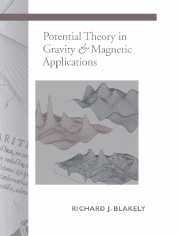Book contents
- Frontmatter
- Contents
- Introduction
- 1 The Potential
- 2 Consequences of the Potential
- 3 Newtonian Potential
- 4 Magnetic Potential
- 5 Magnetization
- 6 Spherical Harmonic Analysis
- 7 Regional Gravity Fields
- 8 The Geomagnetic Field
- 9 Forward Method
- 10 Inverse Method
- 11 Fourier-Domain Modeling
- 12 Transformations
- Appendix A Review of Vector Calculus
- Appendix B Subroutines
- Appendix C Review of Sampling Theory
- Appendix D Conversion of Units
- Bibliography
- Index
7 - Regional Gravity Fields
Published online by Cambridge University Press: 10 October 2009
- Frontmatter
- Contents
- Introduction
- 1 The Potential
- 2 Consequences of the Potential
- 3 Newtonian Potential
- 4 Magnetic Potential
- 5 Magnetization
- 6 Spherical Harmonic Analysis
- 7 Regional Gravity Fields
- 8 The Geomagnetic Field
- 9 Forward Method
- 10 Inverse Method
- 11 Fourier-Domain Modeling
- 12 Transformations
- Appendix A Review of Vector Calculus
- Appendix B Subroutines
- Appendix C Review of Sampling Theory
- Appendix D Conversion of Units
- Bibliography
- Index
Summary
The reduction of gravity data is an excellent example of the enhancement of “signal” by the removal of predictable “noise.”
(Robert W. Simpson and Robert C. Jachens)La gravité est un mystère du corps inventé pour cacher les défauts de l'esprit. [Gravity is a mystery of the body invented to conceal the defects of the mind.]
(La Rochefoucauld)Introduction
Later chapters will focus on techniques to characterize crustal and uppermantle sources on the basis of their associated gravity and magnetic fields. A key initial step in such analyses is the proper separation of the field caused by the target source (the residual or anomalous field) from the field of the remainder of the universe (the regional field). This and the following chapter will attempt to characterize these two components for gravity and magnetic studies, respectively.
Our objective in this chapter is to reduce a gravity measurement made on or near the earth's surface to an anomaly value that reflects density variations in the crust and upper mantle. This involves a long series of operations with a well-established tradition. These operations account for the mass, shape, and spin of a “normal” earth, elevation of the measurements above sea level, tidal effects of the sun and moon, motion of the instrument, gravitational effects of terrain in the vicinity of the measurement, and effects of isostasy. Each of these operations will be addressed in this chapter. Readers wishing additional information are referred to texts by Heiskanen and Moritz and Stacey and to papers by Simpson and Jachens, Chovitz, and LaFehr.
Information
- Type
- Chapter
- Information
- Potential Theory in Gravity and Magnetic Applications , pp. 128 - 153Publisher: Cambridge University PressPrint publication year: 1995
Accessibility standard: Unknown
- 1
- Cited by
